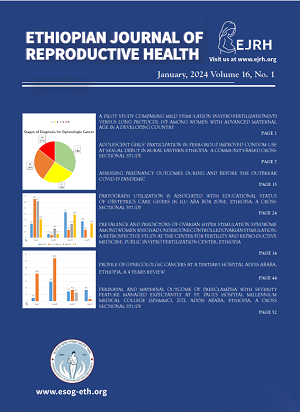Adolescent girls’ participation in peer-group improved condom use at sexual debut in rural Eastern Ethiopia: a community based cross-sectional study
DOI:
https://doi.org/10.69614/ejrh.v16i1.701Keywords:
Adolescent girls, youth, Condom use, Premarital sex, HIV, Peer-groupsAbstract
Background: Adolescent girls engaged in sexual activity are unlikely to use condoms during their sexual debut. Younger adolescents are also not often targeted for sexual-related interventions because of the taboos associated with sexuality in traditional societies. This study examined the association between peer-group participation and condom use at sexual debut among young adolescent girls in rural Eastern Ethiopia.
Design: The study analyzed data from a large quasi-experimental study involving 3290 young adolescent girls aged 13-17. The intervention targeted adolescent girls aged 10 – 14 years. Unmarried sexually active adolescent girls, and married girls who had their sexual debut before marriage were the study population. Multi-level mixed-effect logistic regression analysis was employed to examine associations using STATA/SE version 16 statistical software.
Results Among 3290 adolescent girls surveyed, 258 (7.84%) reported engaging in sexual intercourse. The Mean(+SD) age at sexual debut was 14.36 (+1.32), with no observed statistical difference between the intervention and control groups (p=0.1164). The magnitude of condom use at sexual debut was 22.46%, 95 % CI (14.11, 33.81%). The odds of using condoms during sexual debut among girls who participated in peer-group was 11.51 times higher (Adjusted OR: 11.51, 95% CI: 1.95, 67.84) than those in the control group.
Conclusions Peer group participation improved condom use at sexual debut. Peer groups can be critical for engaging adolescent girls in HIV and other sexually transmitted infection prevention and avoiding unwanted/unplanned pregnancies. Further studies with larger sample size and specifically design research is necessary to generate evidence for scale up of this potentially lifesaving intervention.
References
2. Afriyie J, Essilfie ME. Association between risky sexual behaviour and HIV risk perception among in-school adolescents in a municipality in Ghana. Ghana Med J. 2019;53(1):29–36.
3. Obarisiagbon OE, Ofili AN, Isara AR, Ighedosa SU. Knowledge, Attitude, Practices and associated factors of HIV/AIDS among adolescents in Ora Community, Edo State. Ann Health Res. 2019;5(1):51–64.
4. Mabaso M, Maseko G, Sewpaul R, Naidoo I, Jooste S, Takatshana S, et al. Trends and correlates of HIV prevalence among adolescents in South Africa: evidence from the 2008, 2012 and 2017 South African National HIV Prevalence, Incidence and Behaviour surveys. AIDS Res Ther. 2021 Dec 14;18(1):97.
5. Tavares CM, Schor N, França Junior I, Diniz SG. Factors associated with sexual initiation and condom use among adolescents on Santiago Island, Cape Verde, West Africa. Cad Saúde Pública. 2009 Sep;25(9):1969–80.
6. Central Statistical Agency (CSA) [Ethiopia], ICF. Ethiopia Demographic and Health Survey 2016. Addis Ababa, Ethiopia, and Rockville, Maryland, USA: CSA and ICF; 2017 Jul.
7. Ethiopian Public Health Institute (EPHI. Ethiopia Population-based HIV Impact Assessment (EPHIA) 2017-2018. Addis Ababa, Ethiopia: EPHI; 2020 Aug.
8. Limaye RJ, Babalola S, Kennedy CE, Kerrigan DL. Descriptive and injunctive norms related to concurrent sexual partnerships in Malawi: implications for HIV prevention research and programming. Health Educ Res. 2013 Aug 1;28(4):563–73.
9. Srahbzu M, Tirfeneh E. Risky Sexual Behavior and Associated Factors among Adolescents Aged 15-19 Years at Governmental High Schools in Aksum Town, Tigray, Ethiopia, 2019: An Institution-Based, Cross-Sectional Study. BioMed Res Int. 2020;2020:3719845.
10. Daka D, Shaweno D. Magnitude of risky sexual behavior among high school adolescents in Ethiopia: A cross-sectional study. J Public Health Epidemiol. 2014 Jul 31;6:211–5.
11. Levy E, Gidron Y, Olley BO. A new measurement of an indirect measure of condom use and its relationships with barriers. SAHARA J J Soc Asp HIVAIDS Res Alliance. 2017 Sep 13;14(1):24–30.
12. Jain A, Tobey E, Ismail H, Erulkar A. Condom use at last sex by young men in Ethiopia: the effect of descriptive and injunctive norms. 2018;
13. Gebreselassie G, Deyessa N, Tesfaye G. Intention to use condom among students in Agena preparatory school, Guraghe Zone, Ethiopia: with the application of health believe model. Arch Public Health Arch Belg Sante Publique. 2013;71(1):23.
14. Kassie GM, Mariam DH, Tsui AO. Patterns of knowledge and condom use among population groups: results from the 2005 Ethiopian behavioral surveillance surveys on HIV. BMC Public Health. 2008 Dec 31;8:429.
15. United Nations Children’s Fund. Adolescent HIV prevention: Turning the tide against AIDS will require more concentrated focus on adolescents and young people [Internet]. UNICEF DATA. 2019 [cited 2019 Nov 5]. Available from: https://data.unicef.org/topic/hivaids/adolescents-young-people/
16. Bizu D, Aderaw Z, Kassa GM. Assessment of Early Sexual Initiation and Associated Factors among Preparatory School Students of FaggetaLekoma District, Awi Zone, Northwest Ethiopia, 2015. Int J Clin Med. 2015 Aug 6;6(8):521–9.
17. Woldeamanue BT. Risky sexual behavior and associated factors among high school adolescents in North Shewa zone, Oromia Region, Ethiopia. PAMJ - One Health [Internet]. 2020 Jul 28 [cited 2023 Apr 23];2(18). Available from: https://www.one-health.panafrican-med-journal.com/content/article/2/18/full
18. Emebet T, Shaweno D, Daka D. Prevalence, associated risk factors and consequences of premarital sex among female students in Aletawondo High School, Sidama Zone, Ethiopia. J Public Health Epidemiol. 2014 Jul 31;6:216–22.
19. Girmay A, Mariye T. Risky sexual behavior practice and associated factors among secondary and preparatory school students of Aksum town, northern Ethiopia, 2018. BMC Res Notes. 2019 Oct 26;12(1):698.
20. Abera H, Tamiru F, Kibret GD. Intention toward condom use and its associated factors among students of Debre Work Senior Secondary and Preparatory School, East Gojjam Zone, Amhara Region, Ethiopia. HIVAIDS Auckl NZ. 2017 Jun 19;9:137–43.
21. Ritchwood TD, Penn D, Peasant C, Albritton T, Corbie-Smith G. Condom Use Self-Efficacy Among Younger Rural Adolescents: The Influence of Parent-Teen Communication, and Knowledge of and Attitudes Toward Condoms. J Early Adolesc. 2017 Feb 1;37(2):267–83.
22. Evans WD, Ulasevich A, Hatheway M, Deperthes B. Systematic Review of Peer-Reviewed Literature on Global Condom Promotion Programs. Int J Environ Res Public Health. 2020 Apr;17(7):2262.
23. Covey J, Rosenthal-Stott HES, Howell SJ. A synthesis of meta-analytic evidence of behavioral interventions to reduce HIV/STIs. J Behav Med. 2016 Jun;39(3):371–85.
24. Fasil N, Worku A, Oljira L, Tadesse AW, Berhane Y. Association between sexual and reproductive health education in peer group and comprehensive knowledge of HIV among adolescent girls in rural eastern Ethiopia: a community-based cross-sectional study. BMJ Open. 2022 Oct 1;12(10):e063292.
25. Meekers D, Klein M. Determinants of Condom Use among Unmarried Youth in Yaoundé and Douala, Cameroon [Internet]. Cameroon: PSI; 2001 [cited 2019 Aug 28] p. 24. Report No.: 47. Available from: https://www.psi.org › drupal › sites › default › files › publication_files
26. Vigliotti V, Taggart T, Walker M, Kusmastuti S, Ransome Y. Religion, faith, and spirituality influences on HIV prevention activities: A scoping review. PloS One. 2020;15(6):e0234720.
27. FDRE Ministry of Health. National Adolescent and Youth Health Strategy (2016 - 2020) [Internet]. 2016. Available from: https://www.prb.org/wp-content/uploads/2018/05/National-Adolescent-and-Youth-Health-Strategy-2016-2020.Ethiopia.pdf
28. Guiella G, Madise NJ. HIV/AIDS and Sexual-Risk Behaviors among Adolescents: Factors influencing the use of condoms in Burkina Faso. Afr J Reprod Health. 2007;11(3):182–96.
29. Nubed CK, Akoachere JFTK. Knowledge, attitudes and practices regarding HIV/AIDS among senior secondary school students in Fako Division, South West Region, Cameroon. BMC Public Health [Internet]. 2016 Aug 22 [cited 2020 Feb 11];16(1). Available from: https://www.ncbi.nlm.nih.gov/pmc/articles/PMC4994230/
30. Espada JP, Morales A, Guillén-Riquelme A, Ballester R, Orgilés M. Predicting condom use in adolescents: a test of three socio-cognitive models using a structural equation modeling approach. BMC Public Health. 2016 Jan 14;16:35.



